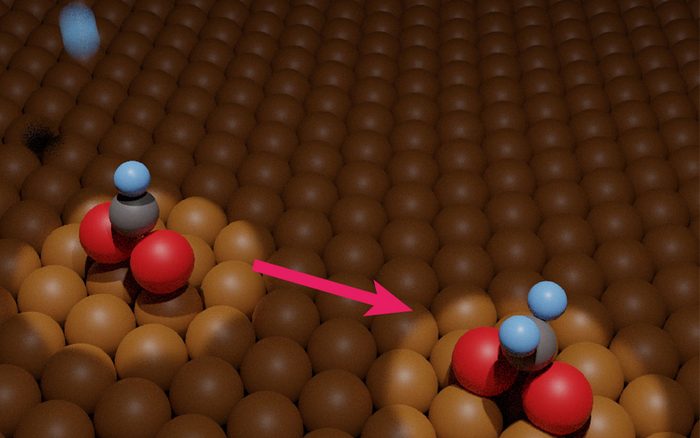The hydrogenation of metal-adsorbed formate has been experimentally measured by University of Tsukuba researchers and collaborators. This innovation will make it easier to convert carbon dioxide pollution into usable methanol fuel.
 Abstract. Image Credit: University of Tsukuba.
Abstract. Image Credit: University of Tsukuba.
The global climate is still changing due to carbon dioxide pollution. Science Advances revealed how researchers can spot such pollutants, even on a regional and almost immediate basis (April 22nd, 2022). Numerous research studies are concentrating on how to transform carbon dioxide pollution into a fuel, such as methanol, as part of an answer to the problem of pollution.
Catalysts made of copper can be used for these transformations. For the best possible conversion of carbon dioxide pollution into methanol fuel, it is essential to know the associated step-by-step chemistry. However, the specifics of this chemistry are yet unknown; tests are required to validate the existing computer simulation-based ideas.
Now, researchers from the University of Tsukuba and working partners have experimentally assessed the hydrogenation of copper-adsorbed formate in a paper that was just published in the Journal of the American Chemical Society. This study will aid in the optimization of key processes in the abovementioned pollutant-to-fuel process, speeding up the manufacturing of methanol.
Hydrogenation of carbon dioxide into methanol is a potential key technology for producing fuel and chemical feedstocks, but optimizing the reaction remains difficult. That’s because it’s difficult to experimentally detect chemical intermediates in the step-by-step reaction mechanism.
Dr. Kotaro Takeyasu, Study Senior Author and Assistant Professor, Faculty of Pure and Applied Sciences, University of Tsukuba
Two important results required the use of temperature-programmed desorption and infrared reflection absorption spectroscopy. First, exposure to atomic hydrogen caused the adsorbed formate to hydrogenate at a temperature of 200 K.
The product’s specific chemical composition is not yet known. Additionally, it was discovered that the hydrogenated formate converted back into adsorbed formate or gaseous formaldehyde in a 96:4 ratio at a temperature of 250 K.
On the basis of our experimental and computational work, the activation energy of the hydrogenation of adsorbed formate is approximately 121 kilojoules per mole. Our results are consistent with reported results of methanol synthesis studies.
Dr. Kotaro Takeyasu, Study Senior Author and Assistant Professor, Faculty of Pure and Applied Sciences, University of Tsukuba
In this line of work, copper-zinc alloys are particularly prevalent. Currently, the research team is comparing the activation energies found in the present work with especially relevant catalytic alloys, which also need experimental and computational investigations.
Researchers will be able to better produce methanol from carbon dioxide, according to the findings of this study. Such efforts will aid in the transformation of air pollution into automobile fuel and industrial chemical feedstocks. It offers a way to give carbon dioxide, which is typically seen as waste, more value. Researchers may have devised a new method for maximizing the use of limited resources by improving the hydrogenation reaction discussed here.
This research was supported in part by grants from the Japan Society for the Promotion of Science for Innovative Area “Hydrogenomics” (grant No. JP18H05519), for Transformative Research Areas (A) “Hyper-Ordered Structure Science” (grant No. JP20H05883), and for Challenging Research (grant No. JP20K21099).
Journal Reference:
Takeyasu, K., et al. (2022) Hydrogenation of Formate Species Using Atomic Hydrogen on a Cu(111) Model Catalyst. Journal of the American Chemical Society. doi.org/10.1021/jacs.2c02797.